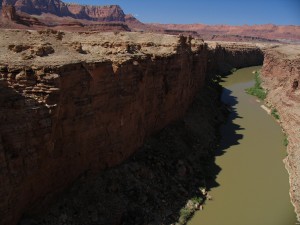9 March 2016
WASHINGTON, DC — Warmer-than-average spring temperatures reduce upper Colorado River flows more than previously recognized, according to a new study.

A late afternoon view of the Colorado River in Marble Canyon upstream of Navajo Bridge, near Lees Ferry, Arizona. New research shows that warmer-than-average spring temperatures reduce upper Colorado River flows more than previously thought.
Credit: Stewart Tomlinson, U.S. Geological Survey.
Although climate models have suggested that spring temperatures affect stream flow, this study is the first to examine the instrumental historical record to see if a temperature effect could be detected, said Connie Woodhouse, a geographer and dendrochronologist at the University of Arizona in Tucson and lead author of the new study.
“Forecasts of stream flow are largely based on precipitation,” Woodhouse said. “What we’re seeing since the 1980s is that temperature plays a larger role in stream flow and in exacerbating drought.”
The bulk of stream flow in the upper Colorado comes from snowpack. However, temperatures during the “runoff season” of March through July can have a significant impact on the amount of water that ends up in the river, the researchers found. The team studied the records of temperature, cool-season precipitation and stream flow for the years 1906 to 2012.
“In certain years, temperature became a very strong influence. It was a bit of a surprise,” Woodhouse said. “If we have a warmer spring, we anticipate that the river flows will be less relative to the amount of snowpack.”
Seven Western states and Mexico use water from the Colorado River for agriculture and for cities. Major U.S. cities that use Colorado River water include Denver, Albuquerque, Salt Lake City, Phoenix, Tucson, Las Vegas, Los Angeles and San Diego.
The team’s study has been accepted for publication in Geophysical Research Letters, a publication of the American Geophysical Union.
From her previous work with water managers in the region, Woodhouse knows they are interested in how temperature affects stream flow in the Colorado River.
She and her colleagues wanted to determine how Upper Colorado River Basin winter precipitation, March-July temperatures and November soil moisture levels influence annual streamflow at Lees Ferry, Arizona.
For each year from 1906 to 2012, the U.S. Bureau of Reclamation estimates natural upper Colorado River flow based on data recorded from stream gauges at Lees Ferry. At that location, Colorado River streamflow reflects water that has drained from the upper basin, which includes Colorado, Wyoming, Utah and New Mexico.
Using the streamflow data, the researchers identified six droughts that occurred in the Upper Colorado River Basin from 1906 to 2012. A drought was defined by consecutive years with below-average streamflow punctuated by no more than one year of normal or above-average flow.
The drought periods were 1931-1940, 1950-1956, 1959-1969, 1972-1977, 1988-1996 and 2000-2012.
For average winter precipitation and March through July temperatures for the Upper Colorado River Basin, the research team turned to a database that provides climatological data at very high spatial resolution for locations all over the U.S. The database goes back more than 100 years.
Soil moisture records don’t exist very back far into the 20th century. Therefore, the team used a hydrologic model, which is based on modern observations, to generate annual averages for November soil moisture going back to 1906.
The team found November soil moisture had only a small effect on streamflow.
The researchers found that winter precipitation and average runoff-season temperatures varied from drought to drought.
“The 1950s was the driest period, but also the coolest,” Woodhouse said. “In contrast, the most recent drought of 2000 to 2012 was the warmest, but only moderately dry.”
If the temperatures during the runoff season were cooler than average, streamflow was higher than expected on the basis of winter precipitation alone, the team found. However, when runoff-season temperatures were above average, streamflow was less than expected on the basis of winter precipitation.
During and since the 1980s, average Upper Colorado River Basin temperatures during the runoff season have been increasing.
“If we have a warmer spring, we can anticipate that the flows will be less relative to the amount of snowpack,” Woodhouse said. “What we’re seeing is not just the future – it’s actually now. That’s not something I say lightly.”
For at least the past decade, climate models have indicated that warming temperatures have an increasing effect in modulating streamflow, she said. The team’s findings, which are based on real, observed data, mirror the predictions of the climate models.
###
The American Geophysical Union is dedicated to advancing the Earth and space sciences for the benefit of humanity through its scholarly publications, conferences, and outreach programs. AGU is a not-for-profit, professional, scientific organization representing more than 60,000 members in 139 countries. Join the conversation on Facebook, Twitter, YouTube, and our other social media channels.
Notes for Journalists
Journalists and public information officers (PIOs) of educational and scientific institutions who have registered with AGU can download a PDF copy of the article by clicking on this link: http://onlinelibrary.wiley.com/doi/10.1002/2015GL067613/full
Or, you may order a copy of the final paper by emailing your request to Lauren Lipuma at [email protected].
Please provide your name, the name of your publication, and your phone number.
Neither the paper nor this press release is under embargo.
“Increasing influence of air temperature on Upper Colorado River streamflow”
Authors:
Connie A. Woodhouse, School of Geography and Development and Laboratory of Tree-Ring Research, University of Arizona, Tucson, Arizona, U.S.A;
Gregory T. Pederson, U.S. Geological Survey, Northern Rocky Mountain Science Center, Bozeman, Montana, U.S.A.;
Kiyomi Morino, Laboratory of Tree-Ring Research, University of Arizona, Tucson, Arizona, U.S.A.;
Stephanie A. McAfee, Department of Geography, University of Nevada, Reno, Reno, Nevada, U.S.A.;
Gregory J. McCabe, U.S. Geological Survey, National Research Program, Water Resources Division, Denver Federal Center, Denver, Colorado, U.S.A.
Contact Information for the Authors:
Connie Woodhouse: +1 520-626-0235, [email protected]
Lauren Lipuma
+1 (202) 777-7396
[email protected]
University of Arizona Contact:
Mari Jensen
+1 (520) 626-9635
[email protected]